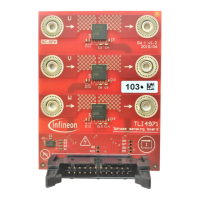EEPROM designed to write under
specified condition on the first shot.
In case of lower voltage (i.e. 15V)
Infineon recommends a margin test
to proof quality of EEPROM content
and repeat the programming-
sequence if needed.
1) Limits for EEPROM programming and margin level test at the same temperature. Alternatively the temperature
characteristic of the margin level test needs to be considered: VTH(T)=VTH(WRITE_ERASE)+0.0016V/K*(TPROG-T).
Please note that only a typical temperature coefficient is used.
4.3 Margin Test
The margin test command is used in order to check the threshold voltages of the programmed EEPROM cells.
For reliable sensor EEPROM operation the threshold level of the cells have to be kept within the specification
(Table 13). After sending the margin test command an external margin voltage can be switched to the control
gates while refreshing the EEPROM-registers by an external trigger, so that the switching threshold of the
EEPROM cells can be identified (Table 13). EEPROM cells programmed to '0' or to '1' need to be tested
separately. For the '1' programmed cells a threshold voltage smaller than the applied margin voltage a '0' will
be stored to the EEPROM registers, for those with a higher threshold a '1'. Vice versa the procedure when
testing '0' programmed cells, for a margin voltage smaller than the threshold a '1' and for those higher than the

